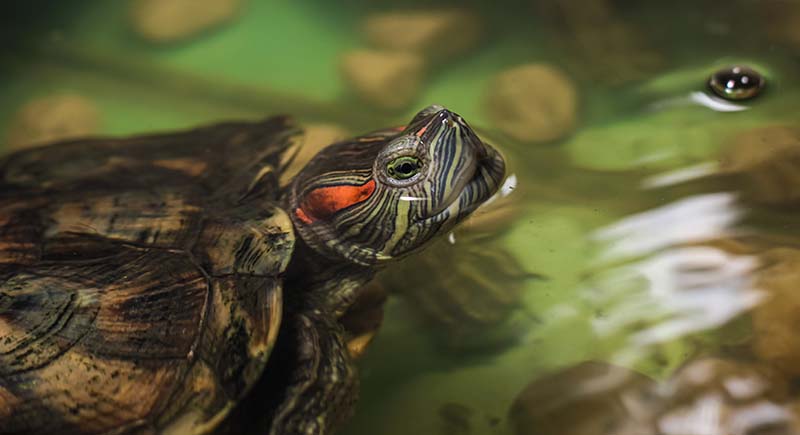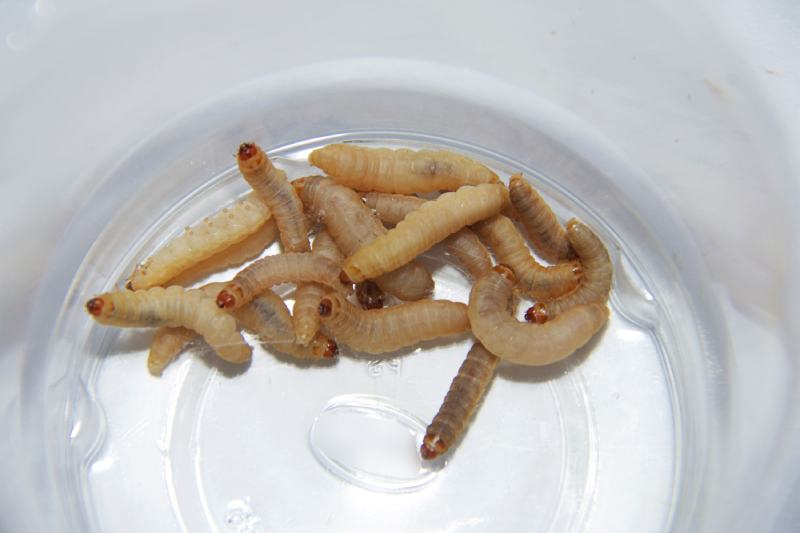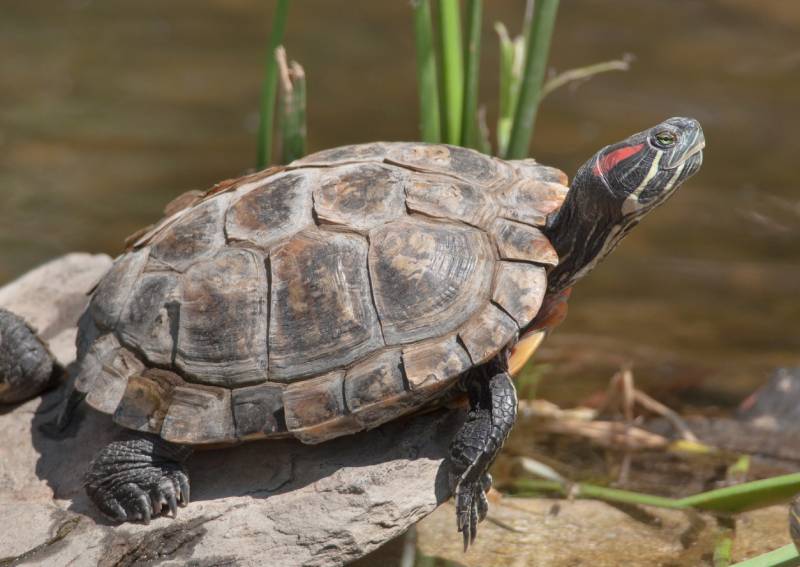Red-Eared Slider Turtle: Pictures, Facts, Diet & Care Guide
Updated on

Reptiles like turtles might not be the first thing that comes to mind when you think of pets, but they can still provide a unique type of companionship. Not to mention they’re a lot of fun to observe! Red-Eared Sliders are the most common species kept as a pet, but that doesn’t mean they are suitable for everyone. Keep reading to learn more about keeping a Red-Eared Slider as a pet, including a detailed care guide.
| Size: | Medium |
| Weight: | Up to 7 lbs |
| Lifespan: | 40 years in captivity |
| Suitable for: | Intermediate to experienced turtle keepers |
| Temperament: | Friendly, calm, intelligent |
Red-Eared Sliders are beautiful reptiles with colorful green shells, yellow underbellies, and distinct red stripes on their heads. They are also one of the most social pet turtles, especially if raised around people. Have you always dreamed of having a turtle eat out of your hand? The Red-Eared Slider has been known to do just that!
Red-Eared Slider Breed Characteristics
How Much Do These Turtles Cost?
Red-Eared Sliders are one of the most common and popular pet turtles you’ll find for sale. Because of that, they are relatively inexpensive, and you’ll pay $15-$40 for a Red-Eared Slider turtle.
Although the reptiles are native to the southern United States, buying a captive-bred Red-Eared Slider is better than capturing a wild animal. Captive-bred Red-Eared Sliders are typically healthier and adapt better to life as a pet. They are more likely to bond with their owners too.
Red-Eared Sliders can generally be purchased from pet stores or reptile breeders. Once you bring your turtle home, have them examined by a reptile veterinarian within 48 hours to ensure they are healthy.

Red-Eared Slider Behavior
Turtles may not be as cuddly and affectionate as other pets like dogs and cats, but they still have unique personalities. Observing your red-eared slide and getting to know your turtle can be a rewarding experience. Compared to other species, the Red-Eared Slider is relatively friendly to humans. They recognize their owners, and some seem excited when their pet parents come home. Here are some more details about what to expect about Red-Eared Slider behavior.
Do These Turtles Make Good Pets?
Red-Eared Sliders are one of the most popular aquatic turtle pets for a reason. Not only are they beautiful reptiles, but they are also quite friendly. Red-Eared Sliders can bond with their owners to a certain extent and learn to associate them with food.
They can learn to eat out of their owner’s hands and may approach the side of their enclosure to interact when they see you. However, Red-Eared Sliders are not the best for inexperienced turtle owners. They have specific care needs and won’t thrive in captivity without the correct diet and environment.

Red-Eared Slider Tank Mates
Adult Red-Eared Sliders can be kept together with a big enough tank. Any fish, shrimp, or other small aquatic creatures you put in the tank will likely end up as turtle food. Some species of larger fish may be able to serve as tank mates for a Red-Eared Slider with enough space and filtration.
However, it’s typically easiest to stick with housing Red-Eared Sliders together. Don’t put any other species of aquatic turtle with a Red-Eared Slider.
Care Sheet & Habitat Setup:
As mentioned, Red-Eared Sliders need the right habitat and diet to stay healthy. Here’s what you need to know before you bring one home.
Light Requirements
Red-Eared Sliders housed indoors need artificial lighting that provides UVB. Ultraviolet light is essential to help the turtle’s body make calcium and prevent bone disease. Typically, 12 hours of light and 12 hours of night work best.
The turtle’s habitat should also feature a basking spot and heat lamp. Keep the basking area at a temperature between 90°–95° Fahrenheit. Don’t place the light or lamp too close to the tank to prevent burning or overheating your pet.
The tank temperature should stay around 80° Fahrenheit with lamps or a heating blanket. Use a tank thermometer to ensure your turtle’s space stays warm but not too hot.

Tank Size
Red-Eared Sliders will appreciate as much space as you can give them! As semi-aquatic turtles, they need access to water deep enough for swimming and space to get out of the water and bask in the heat. The water should be about four to five times longer, three to four times wider, and one and a half times deeper than the size of the Red-Eared Slider.
Young Red-Eared Sliders can usually live in a 20-gallon tank, while adults may need a full 100-gallon tank. If you’re keeping more than one turtle, you’ll need about 25% more space for each one. Glass tanks are usually a better choice than plastic, but you can also build your own enclosure from scratch.
Water Temperature
In the wild, Red-Eared Sliders are native to the Southern United States, where the winters are mild and the water is warm. For pet turtles, the tank water should be kept between 72° and 76° degrees Fahrenheit. Either an under-tank heater or a protected in-water heater can be used.
You’ll need a thermometer in the water, ideally two, near and far away from the heat source, to monitor the temperature. Also, it’s best to enclose the in-water heaters, such as with a PVC pipe, to keep the turtle safe from burns.
Plants
You don’t need to add plants to your Red-Eared Slider’s habitat, but they can make it look nicer and more inviting. The turtle may also enjoy hiding or playing with floating plants. Duckweed or water hyacinth are two options to consider.
Substrate
It’s generally safest to avoid substrate in a Red-Eared Slider tank. Sand or small rocks are easily swallowed and can cause health problems. If you want to place large decorations at the bottom of the tank, make sure the turtle can’t become trapped by them. You’ll also need to remove and clean them regularly.

Filtration
Mechanical filtration is usually best for Red-Eared Slider tanks because they can be messy. External canister filters are the least disruptive and stressful. The filter’s size will depend on how big your tank is and how many turtles you’re housing there.
Things to Know When Owning a Red-Eared Slider:
Now that you know what kind of habitat your Red-Eared Slider needs, here are more details about keeping them healthy.
Food & Diet Requirements
Red-Eared Sliders are omnivores but typically eat a more meat-heavy diet when they’re growing. Improper nutrition is a common cause of health issues in turtles, and the best way to avoid them is to feed a varied diet.
Aquatic plants, fruit, and dark leafy greens can be offered for the vegetarian portion of the diet. Small fish, snails, and insects like worms or crickets are good choices for meat protein. You should also feed them commercial turtle pellets to supplement the fresh food.
Young turtles should eat twice a day, and adults eat once. It’s best to serve as much food as the Red-Eared Slider can eat in 10-15 minutes. Then, remove any uneaten food. Your turtle will also need vitamin and calcium supplements. Your veterinarian can help you choose a good brand and how often to give them.

Size & Growth Chart
Red-Eared Slider hatchlings are usually about an inch long and add roughly an inch of length per year. They’re considered juveniles at 1 year old and are around 2 inches long. The juvenile turtle grows quickly from 1–5 years, reaching adult size by 5.
Male Red-Eared Sliders are typically smaller than females, reaching about 8 inches long. Females may reach 11 inches. Because Red-Eared Sliders take so long to reach their full size, inexperienced owners may not be prepared to care for them properly once grown.
Lifespan and Health Conditions
Pet Red-Eared Sliders regularly live at least 20 years but can live as long as 40 years. Regular vet checkups can help you catch problems early and keep your turtle healthy. Here are some medical conditions your Red-Eared Slider may suffer from.
- Abscesses
- Intestinal parasites
- Metabolic bone disease
- Shell Rot
- Respiratory infections
Male vs Female
As we mentioned earlier, male Red-Eared Sliders are smaller than females. They also have longer tails and larger front claws. Finally, the distance between the male turtle’s vent and the edge of their shell is longer than in females.
It can be tough to sex young turtles until they are at least a couple of years old. However, it’s also illegal to sell turtles until they reach 4 inches long, so by the time they’re available to buy, telling the difference between males and females is easier.
3 Little-Known Facts About Red-Eared Slider
1. They Are an Invasive Species in Many Areas
Caring for Red-Eared Sliders can be tricky for beginners, and the turtles often grow bigger than expected. Overwhelmed turtle owners may intentionally or accidentally release their Red-Eared Sliders into the wild. Unfortunately, outside their native Southern United States, Red-Eared Sliders are considered an invasive species.
For example, in California, the Red-Eared Slider competes with native species, like Western Pond turtles, for food and habitats. They can also pass on diseases and parasites the native turtles aren’t prepared to fight off.
2. They Can’t Close Their Shell Completely
For most species, their primary defense against predators is escaping into their shells and closing them off. However, Red-Eared Sliders can’t completely seal off their shell, so they can’t rely on this method of protection. Instead, they escape from predators by quickly sliding (hence the name) into the water and diving down too deep for their enemies to follow.
3. They Are a Sub-Species of Another Turtle
Red-Eared Sliders are officially classified as a sub-species of Pond Slider turtles. Other subspecies include the Yellow-Bellied Slider and the Cumberland Slider.
Conclusion
Pet owners who don’t have the time for a dog or cat may choose a Red-Eared Slider instead because they feel they are easier to care for. While that is true to a certain extent, keeping a Red-Eared Slider healthy still requires the right environment and diet. As we learned in this article, this species lives a long time and frequently outgrows their tanks. Wildlife officials in many states can testify that many turtle owners are unprepared for what it takes to care for a Red-Eared Slider. However, if you can follow their diet and care guidelines, you’ll have a remarkable companion for over 20 years!
You may also be interested in:
- Yellow-Bellied Slider Turtle: Pictures, Facts, Diet & Care Traits
- 5 DIY Indoor Box Turtle Habitats You Can Build Today (with Pictures)
Featured Image Credit: DiPres, Shutterstock











